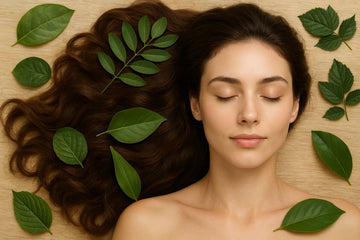Hair thinning and scalp issues can be frustrating, leaving you searching for solutions that don’t rely on harsh chemicals. Many treatments promise results but rarely address the root cause– weak follicles and poor scalp health. Over time, it leads to breakage, dryness, and slower regrowth. A natural, time-tested approach exists.
Using natural leaves for hair growth supplies essential nutrients, antioxidants, and compounds that nourish follicles and restore scalp balance. From curry and hibiscus to bhringraj and neem, these leaves strengthen strands and encourage healthier regrowth, offering a plant-powered path to stronger, fuller hair.
Why Natural Leaves Matter for Hair Growth
Hair thrives when follicles remain nourished and free from buildup. Leaves from medicinal plants supply vitamins, minerals, flavonoids, and essential oils that restore balance without relying on synthetic additives. Many of these leaves have a long history in Ayurveda and traditional medicine, supporting scalp health and strengthening hair roots through natural compounds.
Curry Leaves for Hair Growth
Curry leaves are rich in antioxidants, beta-carotene, and amino acids that strengthen roots and prevent thinning. Their high vitamin B content rejuvenates follicles and improves melanin production, which supports natural pigmentation. Applying curry leaf-infused oil or rinsing with a leaf decoction strengthens strands and slows early greying.
Coriander Leaves for Hair Growth
Coriander leaves contain vitamin C, vitamin K, and essential minerals that detoxify the scalp. They stimulate circulation, making nutrients more available to follicles. Regular application of coriander paste reduces dandruff and refreshes the scalp environment, creating conditions where hair grows stronger and denser.
Moringa Leaves for Hair Growth
Moringa leaves, sometimes called a superfood, carry high levels of vitamin A, zinc, and iron. These nutrients are essential for follicle regeneration. The leaf extract promotes sebum regulation, keeping the scalp moisturised without excessive oil buildup. Moringa leaves for hair growth are particularly effective in preventing breakage and dryness.
Bael Leaves for Hair Growth
Bael leaves are less common but valuable in traditional remedies. They contain anti-inflammatory compounds that soothe irritated scalps. They balance pH and support follicle vitality. Using bael leaves for hair masks or oils ensures follicles receive both antibacterial and antifungal protection.
Guava Leaves for Hair Growth
Guava leaves deliver vitamin C and lycopene, which protect follicles from oxidative stress. A rinse prepared from guava leaves strengthens roots, reduces split ends, and adds shine. Regular use of guava leaves for hair growth also minimises shedding caused by environmental damage.
Hibiscus Leaves for Hair Growth
Hibiscus leaves, when paired with the flower, are a potent combination for thick and voluminous hair. Hibiscus leaves and flowers for hair growth contain amino acids and mucilage that deeply condition strands. They improve scalp circulation, stimulate dormant follicles, and create a natural shine that chemical products cannot replicate.
Parijat Leaves for Hair Growth
Parijat leaves are known in Ayurveda for their calming properties. They contain flavonoids and alkaloids that restore scalp balance. Their anti-inflammatory effects reduce irritation, while their nutrients provide strength to hair shafts. Parijat leaves for hair growth are usually prepared as oil infusions to nourish roots.
Neem Leaves for Hair Growth
Neem leaves stand out for their antibacterial and antifungal qualities. They cleanse clogged follicles, reduce dandruff, and protect against scalp infections that hinder growth. Neem leaves for hair growth are best applied through masks or rinses that purify the scalp.
Betel Leaves for Hair Growth
Betel leaves contain antimicrobial compounds that protect the scalp while delivering calcium and vitamins to follicles. Regular use encourages thicker strands and prevents fungal infections. Betel leaves for hair growth are effective when blended into oil preparations or pastes applied directly to the scalp.
Tamarind Leaves for Hair Growth
Tamarind leaves carry antioxidants and vitamin C, which reduce free radical damage. Their application supports improved follicle strength and scalp detoxification. Tamarind leaves for hair growth work well in masks that promote elasticity and shine.
Fenugreek Leaves for Hair Growth
Fenugreek leaves provide protein and iron, nutrients essential for hair density and resilience. They condition the scalp, reduce dryness, and encourage the regeneration of new strands. Fenugreek leaves for hair growth are most effective when incorporated into hair masks or rinses.
Bhringraj Leaves for Hair Growth
Bhringraj leaves have long been celebrated in Ayurvedic practice as one of the best leaves for hair growth. They contain bioactive compounds that extend the growth phase of follicles, combat premature thinning, and reduce scalp inflammation. Oils prepared from bhringraj leaves consistently support thicker, stronger strands.
Walnut Benefits for Hair
While not leaves, walnuts are frequently paired with herbal remedies because of their omega-3 fatty acids, vitamin E, and biotin. Walnut benefits for hair include nourishing follicles from within, supporting shine, and reducing dryness. When combined with leaf-based treatments, walnut oil elevates scalp nourishment.
How to Use Natural Leaves for Hair Growth
-
Infused Oils: Heating leaves in coconut or sesame oil releases their active compounds, creating a restorative treatment for scalp massage.
-
Decoctions and Rinses: Boiling leaves in water and using the cooled liquid as a final rinse nourishes roots and refreshes the scalp.
-
Hair Masks: Grinding fresh leaves into a paste and applying directly to the scalp delivers nutrients in concentrated form.
-
Herbal Powders: Dried and powdered leaves mixed with carrier oils or yoghurt offer convenience with lasting potency.
Final Thoughts
Turning to natural leaves for hair growth provides a plant-based, nutrient-rich approach that aligns with a health-conscious lifestyle. From curry and coriander to hibiscus and bhringraj, each leaf variety delivers unique benefits that nurture scalp vitality, fortify follicles, and promote thicker strands. Consistent use, combined with balanced nutrition and stress management, creates conditions where hair thrives naturally.
Also : Shatavari for Weight Gain: How It Helps and How to Use It Effectively










